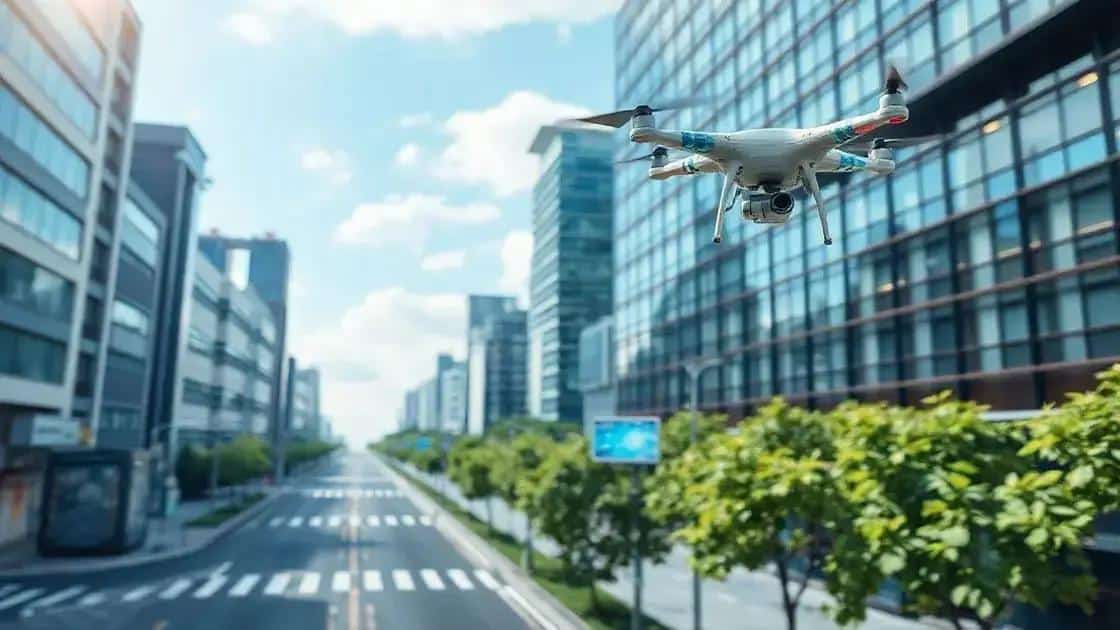Urban air quality monitoring through sensor networks

Urban air quality monitoring through sensor networks enables real-time tracking of pollution levels, improves public health, and fosters community engagement while leveraging advanced technologies for effective data analysis.
Urban air quality monitoring through sensor networks has become crucial in today’s rapidly urbanizing world. Have you ever wondered how clean or polluted the air you breathe really is? Let’s dive into this vital topic.
Understanding air quality monitoring
Understanding air quality monitoring is essential for maintaining a healthy environment, especially in urban areas. With increasing pollution levels, effective monitoring systems have become crucial for public health and safety.
At its core, air quality monitoring involves measuring specific pollutants in the atmosphere. This includes harmful gases such as carbon monoxide, nitrogen dioxide, and particulate matter. By analyzing these data points, we can better understand the air we breathe.
Key Components of Air Quality Monitoring
There are several components that make up an effective air quality monitoring program:
- Sampling Stations: These are strategically placed throughout an area to collect air samples.
- Data Collection: Sensors gather information on various pollutants over time.
- Analysis Software: This software interprets the data to provide insights into air quality levels.
- Public Reporting: Result findings are communicated to the public, often through online platforms.
Using these components, cities can determine pollution sources and trends. For instance, if data shows high levels of particulate matter in a specific area, city planners can investigate and take necessary action. Understanding these patterns allows for better urban planning and public health initiatives.
Moreover, air quality monitoring helps in raising public awareness about environmental health. Individuals can make informed decisions based on air quality reports. For example, knowing when pollution levels are high can encourage people to limit outdoor activities.
Benefits of Effective Air Quality Monitoring
Effective air quality monitoring brings numerous benefits:
- Improved Public Health: Reduces exposure to harmful pollutants.
- Regulatory Compliance: Helps cities meet environmental standards.
- Better Quality of Life: Contributes to cleaner and healthier urban environments.
In conclusion, understanding air quality monitoring is vital for creating healthier cities. By taking advantage of advanced technologies and data analysis, urban areas can significantly reduce pollution levels and safeguard the health of their residents.
Advantages of sensor networks in urban settings

The advantages of sensor networks in urban settings are becoming increasingly evident as cities seek to improve environmental monitoring. These networks provide real-time data that can lead to significant improvements in urban air quality.
One of the primary benefits is the ability to collect data across various locations simultaneously. This means that cities can monitor air quality comprehensively, identifying hotspots of pollution and areas that may need intervention.
Key Benefits of Sensor Networks
Some of the most important advantages include:
- Real-Time Monitoring: Instant data allows for immediate responses to pollution spikes.
- Cost-Effectiveness: Sensor networks are often cheaper to deploy compared to traditional monitoring methods.
- Scalability: Networks can be expanded easily to cover new areas as cities grow.
- Community Engagement: Public access to data fosters awareness and involvement in air quality issues.
This real-time monitoring capability is crucial for urban planners and policymakers. By visualizing air quality data, they can make informed decisions about traffic management, public transport, and even green spaces.
Moreover, integrating these networks with advanced data analytics can yield valuable insights. For instance, analyzing trends in pollution levels can help communities understand the impact of construction projects or traffic patterns.
Impacts on Public Health
Another critical aspect is the impact on public health. With sensor networks, urban areas can quickly identify unhealthy air quality conditions. By alerting residents during high pollution days, cities can take proactive measures.
These networks also contribute to long-term health improvements by allowing for studies that correlate air quality with health outcomes. For example, research can show how lower pollution levels lead to reduced respiratory problems among inhabitants.
Finally, the combination of sensor networks and public data sharing creates opportunities for innovation. startups and local entrepreneurs can use this data to develop solutions aimed at improving urban life, from mobile apps to community initiatives.
Implementation strategies for effective monitoring
Effective implementation strategies for air quality monitoring are crucial for obtaining accurate and useful data. Cities can take several steps to ensure their monitoring systems operate efficiently and effectively.
First, establishing a clear plan is essential. This plan should outline the specific goals of the monitoring program, such as identifying pollution hotspots or tracking changes over time.
Key Steps in Implementation
Here are some key steps cities can follow:
- Site Selection: Choose monitoring sites based on population density and known pollution sources.
- Technology Selection: Use a mix of high-quality sensors and cost-effective devices to optimize performance.
- Data Integration: Ensure that data from various sensors is integrated into one system for comprehensive analysis.
- Community Involvement: Engage local communities to increase awareness and promote involvement in the monitoring process.
Additionally, training personnel who manage the monitoring systems is vital. Proper training ensures that all users understand how to operate equipment and analyze data. Regular maintenance of the sensors is also necessary to guarantee reliable measurements over time.
Regular data analysis is another important aspect. Cities should schedule periodic evaluations of air quality data to identify trends, assess compliance with regulations, and adapt monitoring strategies as needed.
Long-Term Strategies for Success
Looking at long-term strategies, cities should consider establishing partnerships with academic institutions or non-profit organizations. These partnerships can provide valuable expertise and additional resources, enhancing the effectiveness of monitoring initiatives.
In addition, leveraging modern technology plays a significant role in effective monitoring. For example, utilizing cloud computing for data storage and analytics can improve accessibility and processing speed.
Finally, cities should make monitoring data available to the public. Transparency builds trust and encourages community participation in air quality issues. As residents become more aware of air quality, they can take action to protect their health.
Future trends in air quality technology

Future trends in air quality technology promise to improve how we monitor and manage urban air quality. As cities grow and pollution challenges increase, innovative solutions are essential.
One significant trend is the rise of smart sensors. Unlike traditional sensors, these devices offer better accuracy and connectivity. Smart sensors can communicate data in real time, allowing for quicker responses to changes in air quality.
Emerging Technologies
Digital technologies are reshaping the landscape of air quality monitoring. Some notable advancements include:
- IoT Integration: The Internet of Things (IoT) enables multiple devices to share data, enhancing overall monitoring.
- Machine Learning: Algorithms analyze large data sets to predict pollution trends and identify sources.
- Mobile Applications: Users can access real-time air quality information via their smartphones.
- Low-Cost Sensors: Accessible and affordable sensors encourage community participation in air quality monitoring.
These technologies not only improve data collection but also enhance public awareness. When information is readily available, people can make informed decisions about their health based on real-time data.
Moreover, merging air quality technology with big data analytics allows cities to develop predictive models. These models can forecast air quality levels days ahead, enabling authorities to implement preventive measures effectively.
Innovative Community Solutions
Community-based monitoring is gaining traction as well. Empowering citizens to use tech tools for reporting air quality can lead to grassroots movements advocating for cleaner air. Social platforms facilitate sharing data and experiences, creating a more informed populace.
The integration of air quality solutions into urban planning is another promising trend. As cities implement green infrastructure, such as parks and green roofs, air quality sensors can continuously monitor their effectiveness in reducing pollution.
Lastly, ongoing research and development in this field will likely lead to breakthroughs in detection capabilities. Technologies like drone-based monitoring can provide a comprehensive view of air quality across larger areas.
air quality monitoring through sensor networks and advanced technology is vital for healthier cities. By utilizing smart sensors and community engagement, cities can effectively track pollution levels and promote public awareness. Moreover, future trends indicate exciting possibilities, including IoT integration and predictive analytics, which can further enhance monitoring efforts. Together, these solutions will lead to cleaner air and healthier environments for everyone.
FAQ – Frequently Asked Questions about Urban Air Quality Monitoring
What are the main benefits of using sensor networks for air quality monitoring?
Sensor networks provide real-time data, allowing cities to quickly identify pollution spikes and take action, resulting in better public health.
How can communities get involved in air quality monitoring efforts?
Communities can engage by using mobile apps to access air quality data, participating in local initiatives, and advocating for cleaner air policies.
What role does technology play in improving air quality monitoring?
Technology enhances air quality monitoring through smart sensors, IoT integration, and advanced data analytics, making it easier to track pollution trends.
Why is public access to air quality data important?
Public access fosters awareness and helps individuals make informed decisions about their health, encouraging community participation in air quality issues.





